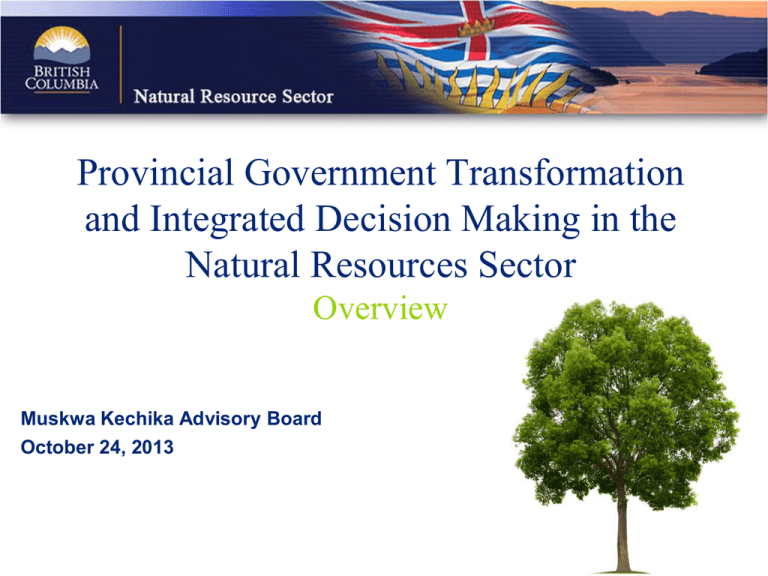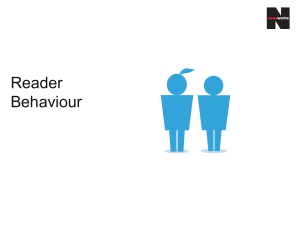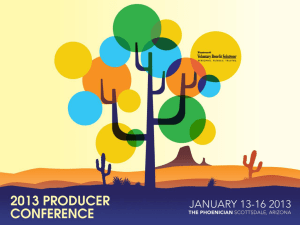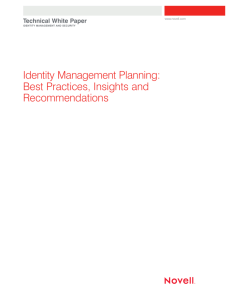IDM - Muskwa-Kechika Management Area
advertisement

Provincial Government Transformation and Integrated Decision Making in the Natural Resources Sector Overview Muskwa Kechika Advisory Board October 24, 2013 The natural resource sector aims to bring about “a prosperous future for all British Columbians through sustainable economic development and shared leadership of our natural resources” Building on our collective successes under One Land Base, One Land Manager, our vision will ensure we are driving towards our future state: where we work together to create lasting value, protect the environment, and actively invest in economic and social prosperity for all British Columbians 1 Why is transformation needed? Management of today’s natural resources are increasingly complex, increased service delivery demands and with less human and financial resources available. Drivers of Transformation Description Demographics A decrease in NRS government employees by 7.1% is projected over the next three years Program changes Uncoordinated development in the NRS creates unintended impacts to environmental, societal and economic values and complexity in the trade-offs that exist in the decisions made by the sector Technological changes The NRS has approximately 100 systems currently associated with authorizations that are independent of one another or with varying degrees of connectivity creating the need for multiple access points and record keeping systems Economic or business changes Increased demands on government financial resources are resulting in greater financial pressures on current and aging business processes and systems Environmental factors An integrated view of BC’s natural resources will support the management of BC’s ecosystems and natural heritage Social changes Expectations of government service delivery are changing rapidly as a result of advances in technology resulting in demand for more services through more channels Legislation Current legislation has evolved over time and continues to carry over a number of gaps, limitations and conflicts 2 IDM enables the broader BC Government and NRS Transformations • IDM is a key piece of the NRS Transformation • The NRS transformation aligns to the over-arching government changes to people and systems to the end of Citizens @ the Centre Supporting strategies & documents Transformation Programs BC Government Transformation People Change • Citizens @ the Centre : BC Government 2.0 • One Land Base / One Land Manager Vision • NRS Transformation Plan • IDM Addendum • Business Architecture • ISSS for the NRS Systems Change Better Citizens’ Service NRS Transformation People Process Systems IDM People 3 Process Legislation Systems & Data NRS has been committed to integration with IDM being the next critical step in the transformation NRS has been long committed to integration with Integrated Decision Making (IDM) being the next critical step in the transformation 1992 Commission on Resources and Environment (CORE), a precursor to Land and Resource Management Planning (LRMPs), is established 2002 MSRM introduces joint work planning with sister NRS ministries in regions (various iterations of joint resource management up to NRO 2004 2001 The Ministry of Sustainable Resource Management is created to improve the integration of natural resource policy and operations 2004 Creation of FCBC – One Window for NRS authorizations January Scoping and planning activities for IDM begin 4 2005 2007 Resource Management Coordination Program (RMCP) is launched to increase natural resource management integration and efficiencies 2006 2007 2005 The Deputy Minister to the Premier and PSA tour province with demographics analysis: 40% will retire by 2020 and an equal amount will pursue other opportunities. Budget pressures will increase – key drivers of NRS integration June A new cabinet is formed resulting in the introduction of a new ministry– MLNGD 2008 2010 Structure impediments to full integration lead to the creation of the Ministry of Natural Resource Operations (MNRO), and in 2011 MFLNRO 2009 2010 2009 In striving for a longterm sustainable service delivery, the Integrated Land Management Board (ILMB) board (a precursor to the NRS board) expands the scope of RMCP July Dave Nikolejsin is named the Transformation Executive Sponsor 2012 The NRS transformation plan is unveiled, including plans for Integrated Decision Making (IDM) 2011 2012 2012 NRS Board approves a proposal to harmonize legislation and associated regulation and policy September The final business case was submitted to the OCIO for endorsement 2013 Transformation of Management Regimes from Vertical to a balance of Vertical and Horizontal • Historical management of Natural Resources has been vertical by sector. This is necessary to provide economic development opportunities • Current (transformative) need is to balance public interest (e.g. Cumulative effects) and efficiencies with economic development Transformation of Management Regimes in NR Sector Vertical Management Forest Sector Recreation Energy Tourism Mining Oil and Gas Move to Horizontal Management to better serve the public interest (integration of resource management) Move to Horizontal Management to increase efficiencies in sector administration 5 IDM is a seven year journey to align legislation, processes, people and technology for an integrated delivery of NRS services The IDM transformation is… “…a series of initiatives designed to align legislation, processes, people and technology to allow for the integrated management of BC’s natural resources” Purpose: To transform the way services are delivered, the way in which natural resources are managed, and the way in which decisions are made Key Benefit Areas: Improved Economic Public & Growth & First Nations Job Creation Engagement Lower Risk Exposure Integrated Resource Stewardship & Management Increased Workforce Productivity More Efficient Technology Infrastructure Improved Service Delivery Timeline: The IDM transformation, spanning 7 years with planning activities already underway, will deliver benefits early and often following a ramp up in effort in FY13/14 6 How will IDM be delivered? • IDM is large in scope—it will be delivered by breaking it down into manageable implementation programs and projects (8 programs shown below) • An estimated 190 internal staff will be involved in the transformation at the peak of year 4 • Additional NRS staff will be consulted and engaged throughout the transformation • Broad external engagement and communications will occur throughout the life of the project • A key goal will be to minimize impact to operational / business-as-usual activities • Discussions to determine how to best leverage cross-government capabilities will continue throughout the planning and implementation phase IDM 7 Legislation, Regulation & Policy Resource Stewardship Authorizations Compliance & Enforcement First Nations Consultation & Engagement Support Functions Common IM/IT Infrastructure Portfolio 10 Projects 5 Projects 14 Projects 3 Projects 3 Projects 4 Projects 24 Projects 7 Projects A substantial amount of IDM is focused on improving effectiveness and efficiency of decision-making activities, processes and systems • Efforts to streamline decision-making activities, processes and systems create the capacity for the sector to further invest in other high priority areas IDM Investment Investment spent to streamline… will enable greater focus on… Clearly establish the desired state and set objectives, priorities and expectations Make decisions related to natural resource development in line with desired state Integrated Natural Resource Management Adjust development regime or desired state as necessary 8 Check effects relative to desired state to embed quality and consistency A streamlined process will support the sector’s ability to make timely, durable authorization decisions Make decisions related to natural resource development in line with desired state • Application intake • Data entry • Legacy system costs • Physical document storage • Decision making • Data accessibility • Smart forms • Adaptable systems • Licensing • Permitting • Online review / comment Supported by NR Sector Legislation, Regulation and Policy Harmonization 9 Integrated Service and Systems Strategy (Technical Solutions) Authorizations Life Cycle 10 IDM Key Messages - DRAFT Additional functions are included to further NRS’s ability to act as an effective integrated manager and steward of BC’s natural resources Clearly establish the desired state and set objectives, priorities and expectations Check effects relative to desired state to embed quality and consistency • Resource focused strategic planning • Cumulative effects management • Sector plans • Land use plans • Harvest plans • Forest sector plans • Integrated resource monitoring • Stewardship decision support • Public feedback • Data analytics • Information • Compliance & enforcement Supported by NR Sector Legislation, Regulation and Policy Harmonization 11 Integrated Service and Systems Strategy (Technical Solutions) At different stages of the roadmap, the number of NRS staff will be required to support the transformation will vary • Each program will be led by program directors and program management resources, supported by seconded staff and external parties for project delivery • The degree of involvement of sector staff will be based on requirements and availability • A key goal will be to minimize impact to operational / business-as-usual activities • An estimated 190 internal staff will be involved in the transformation at the peak of year 3 • Additional NRS staff will be consulted and engaged throughout the transformation • Discussions to determine how to best leverage cross-government capabilities will continue 200 190 400 Number of FTEs 350 190 110 300 Internal Resources 150 80 250 200 150 External Resources 160 160 100 50 70 50 100 60 30 50 FY 14/15 12 FY 15/16 FY 16/17 FY 17/18 FY 18/19 FY 19/20 FY 20/21 * FTE requirements are subject to change as analysis may be refined to reflect latest updates A number of planning activities are already underway Over the course of the past six months, we have completed or are on track to complete a number of key activities that inform the long-term IDM planning Current Key Activities & Deliverables Business Architecture: Improving efficiency and management of the NRS delivery processes for both business and technology (maintain policies, deliver better) Governance Model/PMO Design: A reporting, accountability and governing model to govern and manage the delivery of projects (logistical management of IDM) Change Management and Communications Strategy: An internal and external framework to transition NRS staff and engage stakeholders Implementation Roadmap: A seven-year timeline outline the sequence of priority projects and activities for transformation S Business Case: Supported by the benefits realization framework to detail value of IDM to NRS and the government Application Disposition: An identification and prioritization process to classify systems for building a common infrastructure – Test Prototype under development. Legislation Harmonization: A streamlining, consolidation and modernization effort to remove red-tape that prevents integration and coordinated decision making 13 IDM leadership is committed to integration and is prepared to take the necessary steps to move IDM forward • A major milestone is approaching in the submission of the business case on Sept 20th • Leading up to the funding decision, key readiness activities will take place that are aimed at preparing the sector for transformation • Funding decision will determine whether or not additional prioritization of the implementation plan will be required in order to initiate IDM IDM Funding Sep 20 – Submission of Business Case IDM Long Term Planning TBD – Business Case Decision Transformation Readiness End of Fiscal Year a) If fully funded Initiate IDM b) If not fully funded Reassess and Prioritize Implementation Plan 14









